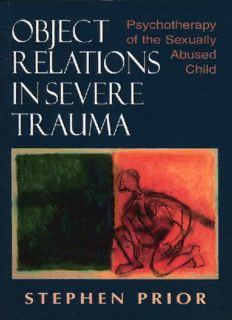
Object Relations in Severe Trauma: Psychotherapy of the Sexually Abused Child PDF
Preview Object Relations in Severe Trauma: Psychotherapy of the Sexually Abused Child
OBJECT RELATIONS IN SEVERE TRAUMA OBJECT RELATIONS IN SEVERE TRAUMA Psychotherapy of the Sexually Abused Child STEPHEN PRIOR, PH.D., PSy.D. A JASON ARONSON BOOK ROWMAN & LITTLEFIELD PUBLISHERS, INC. Lanham· Boulder· New York· Toronto· Oxford A JASON ARONSON BOOK ROWMAN & LITTLEFIELD PUBLISHERS, INC. Published in the United States of America by Rowman & Littlefield Publishers, Inc. A wholly owned subsidiary of The Rowman & Littlefield Publishing Group, Inc. 4501 Forbes Boulevard, Suite 200, Lanham, Maryland 20706 www.rowmanlittlefield.com POBox 317, Oxford, OX2 9RU, UK Copyright © 1996 by Stephen Prior First Rowman & Littlefield Edition 2004 All rights reserved. No part of this publication may be reproduced, stored in a retrieval system, or transmitted in any form or by any means, electronic, mechanical, photocopying, recording, or otherwise, without the prior permission of the publisher. British Library Cataloguing in Publication Information Available Library of Congress Cataloging-in-Publication Data Prior, Stephen. Object relations in severe trauma: psychotherapy of the sexually abused child / by Stephen Prior. p. cm. Includes bibliographical references and index. 1. Sexually abused children-Rehabilitation. 2. Sexually abused children-Mental health. 3. Sexually abused children-case studies. 4. Object relations (Psychoanalysis). 1. Title. RJ507.S49P75 1996 618.92'85836-dc20 95-32752 ISBN 978-0-7657-0018-6 ISBN 0-7657-0018-2 (pbk.: alk. paper) Printed in the United States of America eN The paper used in this publication meets the minimum requirements of American National Standard for Information Sciences-Permanence of Paper for Printed Library Materials, ANSIINISO Z39.48-1992. CONTENTS Preface vii Aclmowledgtnents xi 1 Introduction 1 2 Trauma and Tragedy 17 Joey 20 Fred 23 3 On the Absence of an Adequate Theory 29 The Conceptual Setting 31 Borderline Children 33 The Changing Conceptual Framework 42 Attempts at Integration 51 vi Contents 4 Relational Dilemmas of Abused Children 59 Relentless Reliving of Victim-Victimizer Experiences 62 Identification with the Aggressor 64 Perverse Object Contact 68 Self-Blame 70 Possession 73 5 Internalized Models of Relationship 79 Psychic Structure 82 Masochism, Perversion, and the Need for Relatedness 84 Attachment Theory's Perspective on Internalized Object Relations 88 On the Function of Negative Introjects in the Psyche 93 Theoretical Summary 104 6 Where Is Trauma in Traditional Theory? 107 7 The Dilemma of Therapy and the Uses of Violence 125 8 A Case Study 139 9 Summary 165 Appendix: Contraindications 171 References 175 Index 185 PREFACE This book outlines an object relational theory of the consequences of the sexual traumatization of children. It is based on the intensive psychotherapeutic treatment of seriously disturbed boys who had suffered multiple forms of neglect and abuse. To understand the suffer ing of these children and to create forms of treatment suited to them, I found that I had to develop theory as I went along, for there were no existing conceptual izations that explained the distress of these children or their treatment. Using object relations theory, I have attempted to characterize the ways in which neglect and abuse distort fundamental needs and psychic structures in the child. What I present is clinical theory. By this I mean theory in which conceptualization and therapeutic viii Preface practice are integrated in such a way that each explains and elaborates the other. The ideas and methods evolved together, and their joint presentation illumi nates more, I believe, than one without the other. The case material is presented in some detail, to reveal the nature of the treatment process and the fundamental transference issues. The theory is nonetheless quite comprehensive. Based in part on the work of W. R. D. Fairbairn, Bernhard Berliner, and Rudolf Ekstein, it analyzes the psychological response to trauma in terms of the repetition of abusive patterns of relationship, identification with the aggressor, self-blame, and the seeking of object contact through sexuality or violence. This scope makes the theory applicable to a variety of treatment situations, such as the psychotherapy of adults who were abused as children. The overall per spective may be of value in other contexts as well, such as group and family treatment, milieu therapy, case management, and forensics. As the integration of the concepts and methods described in this book took shape, it began to reveal why both psychodynamic and trauma-oriented theories have had difficulty conceptualizing and treating the psychological consequences of overt trauma. Psycho dynamic theory has seemed unable to give a substan tive causal role to overt events and relationships and has had difficulty conceptualizing the impact of abuse. Trauma theories have focused on external events to such an extent that the scope and depth of psychic in jury contingent on psychological trauma is often not fully appreciated or conceptualized. Articulation of the difficulties within existing theories clarifies the propos als I have made and will, I hope, lead to further advances Preface ix in the treatment of those who have suffered interper sonal trauma. I have attempted to synthesize these various consid erations in order to present a coherent perspective on sexual traumatization in children and its treatment. Theory, practice, and metapsychological reflection must, I believe, evolve together-in part because we know so little in each domain. I hope that this book weaves these strands together in such a way that greater clarity is brought to each area. I also hope that my ef forts might inspire others to attempt this kind of inte grative venture.
Description: